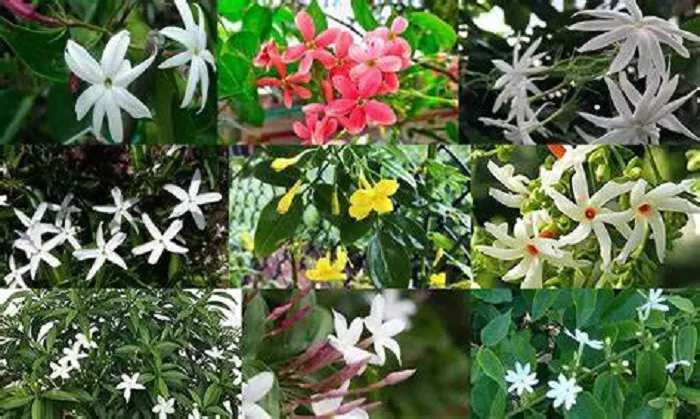Jasmine, a name that evokes the delicate scent of blooming flowers and the gentle touch of nature. With its wide variety of species, jasmine has long been a favorite among gardeners and flower enthusiasts alike. From the classic white blooms to the more exotic varieties, each type of jasmine brings its own unique charm and fragrance to any garden. In this article, we will explore the diverse world of jasmine plants, discovering the different types and their distinctive characteristics.
The Diversity of Jasmine Plants
A Brief Overview of Jasmine Varieties
Jasmine plants belong to the genus Jasminum, which is part of the olive family. There are over 200 species of jasmine worldwide, each with its own unique features and growing requirements. These plants can be found in various forms, from climbers to shrubs, and they thrive in different climates, making them a versatile choice for gardens of all kinds.
Popular Types of Jasmine
Common Jasmine (Jasminum officinale)
Common jasmine is one of the most well-known varieties. It is a vigorous climber that can reach heights of up to 10 meters. Its white, star-shaped flowers bloom in clusters and emit a sweet, intoxicating fragrance, especially at night. This variety is hardy and can tolerate a range of climates, making it a popular choice for gardeners in temperate regions.
Star Jasmine (Trachelospermum jasminoides)
Despite its name, star jasmine is not a true jasmine but is often grouped with them due to its similar appearance and fragrance. This evergreen vine features small, white, star-shaped flowers that bloom in late spring and early summer. It is a popular choice for covering walls and trellises, adding a touch of elegance to any garden.
Winter Jasmine (Jasminum nudiflorum)
Winter jasmine is a deciduous shrub that blooms in late winter and early spring, often before its leaves appear. Its bright yellow flowers provide a cheerful splash of color during the colder months. This variety is hardy and can tolerate a variety of soil types, making it an excellent choice for adding winter interest to your garden.
Lesser-Known Jasmine Varieties
Arabian Jasmine (Jasminum sambac)
Arabian jasmine is a tropical species native to South Asia. It is a compact shrub with small, white flowers that are highly fragrant. This variety is often used in the production of perfumes and essential oils. It thrives in warm climates and requires regular watering and well-drained soil.
Primrose Jasmine (Jasminum mesnyi)
Primrose jasmine is a semi-evergreen shrub with large, trumpet-shaped flowers that range from white to pale yellow. It blooms in late spring and early summer and is known for its vigorous growth. This variety is hardy and can tolerate a variety of conditions, making it a great addition to any garden.
Cape Jasmine (Gardenia jasminoides)
Although not a true jasmine, Cape jasmine is often included in jasmine collections due to its similar fragrance. This evergreen shrub features large, creamy-white flowers that bloom in late spring and early summer. It is a popular choice for adding a touch of tropical elegance to gardens and is often used in landscaping.
Growing and Caring for Jasmine Plants
Choosing the Right Jasmine for Your Garden
When selecting a jasmine plant, consider the climate and growing conditions of your garden. Some varieties, like common jasmine, thrive in temperate climates, while others, such as Arabian jasmine, require a tropical environment. Additionally, think about the space you have available, as some jasmine plants can grow quite large.
Planting and Soil Requirements
Most jasmine plants prefer well-drained soil that is rich in organic matter. They can tolerate a range of soil types, from sandy to clay, but it is important to ensure good drainage to prevent root rot. When planting, choose a location that receives plenty of sunlight, as most jasmine varieties require at least six hours of direct sunlight per day.
Watering and Fertilizing
Jasmine plants require regular watering, especially during the growing season. Keep the soil consistently moist but not waterlogged. In terms of fertilization, use a balanced fertilizer in early spring to promote healthy growth and abundant blooms. Avoid over-fertilizing, as this can lead to excessive foliage growth at the expense of flowers.
Pruning and Maintenance
Pruning is essential for maintaining the shape and health of your jasmine plant. For climbing varieties, prune in late winter or early spring to encourage new growth and remove any dead or damaged branches. For shrubs, prune after flowering to maintain a compact shape and promote bushier growth.
The Beauty and Benefits of Jasmine Plants
Aesthetic Appeal
Jasmine plants add a touch of elegance and beauty to any garden. Their delicate flowers and fragrant blooms create a serene and inviting atmosphere, perfect for relaxation and enjoyment. Whether used to cover a trellis, planted as a hedge, or grown in a container, jasmine plants enhance the visual appeal of your outdoor space.
Fragrance and Aromatherapy
The sweet fragrance of jasmine flowers is not only pleasing to the senses but also has therapeutic benefits. Jasmine is known for its calming and uplifting properties, making it a popular choice for aromatherapy. The scent of jasmine can help reduce stress and anxiety, promoting a sense of well-being and relaxation.
Attracting Wildlife
Jasmine plants are also beneficial for wildlife. Their flowers attract bees, butterflies, and other pollinators, helping to support local ecosystems. Additionally, some varieties of jasmine provide shelter and nesting sites for birds, making them a valuable addition to any wildlife-friendly garden.
Conclusion
Jasmine plants offer a world of beauty, fragrance, and versatility. With over 200 species to choose from, there is a jasmine variety to suit every garden and gardener. Whether you are drawn to the classic charm of common jasmine or the exotic allure of Arabian jasmine, these plants are sure to enhance your outdoor space. By understanding the different types and their growing requirements, you can enjoy the many benefits that jasmine plants have to offer. So why not add a touch of jasmine to your garden and experience the magic of these delightful plants for yourself?


